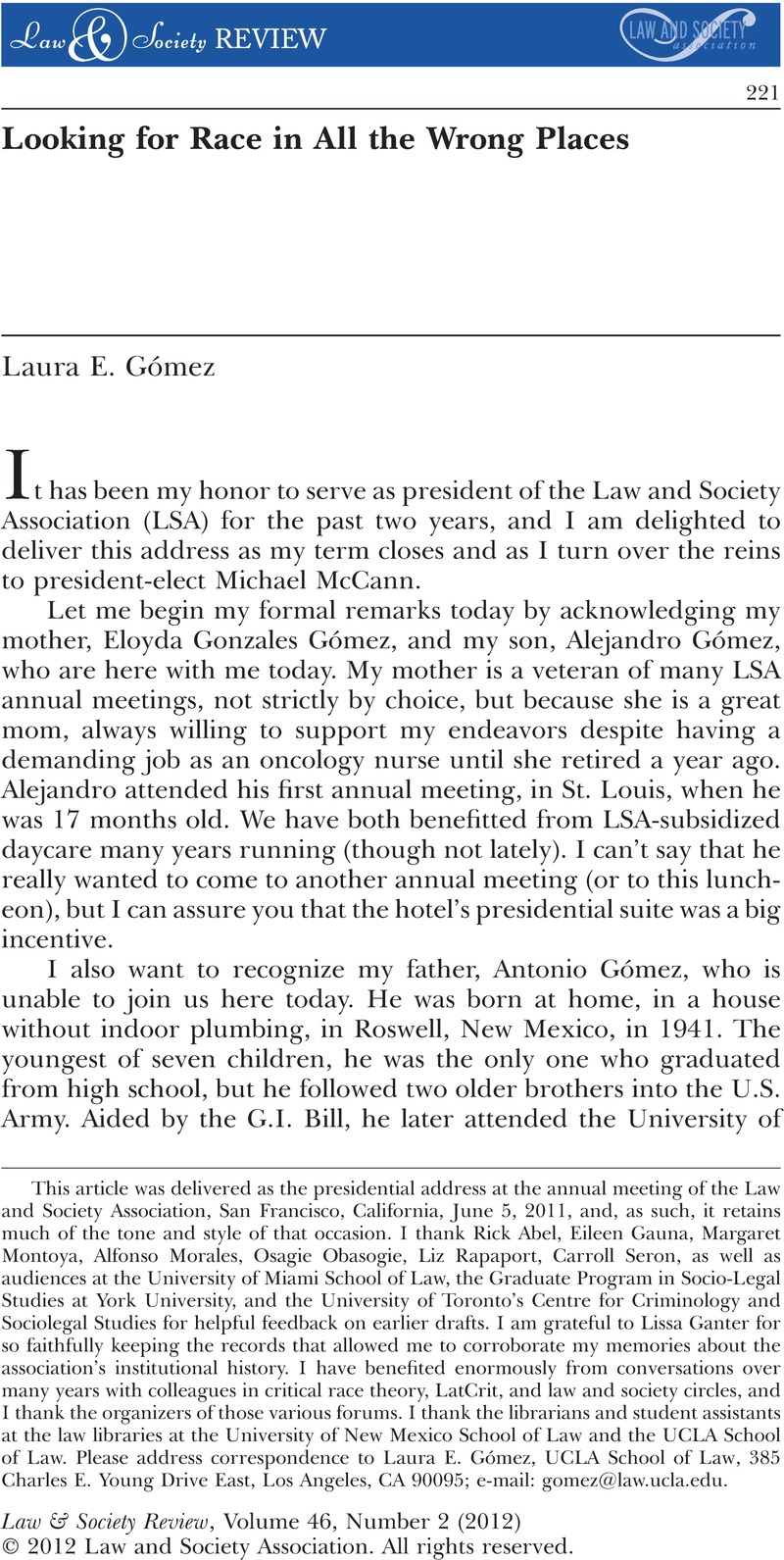Crossref Citations
This article has been cited by the following publications. This list is generated based on data provided by
Crossref.
Lawrence, Charles
2012.
Listening for Stories in All the Right Places: Narrative and Racial Formation Theory.
Law & Society Review,
Vol. 46,
Issue. 2,
p.
247.
Seron, Carroll
Coutin, Susan Bibler
and
White Meeusen, Pauline
2013.
Is There a Canon of Law and Society?.
Annual Review of Law and Social Science,
Vol. 9,
Issue. 1,
p.
287.
Powers, Jeanne M.
2014.
On Separate Paths: The Mexican American and African American Legal Campaigns against School Segregation.
American Journal of Education,
Vol. 121,
Issue. 1,
p.
29.
Carbado, Devon W.
and
Roithmayr, Daria
2014.
Critical Race Theory Meets Social Science.
Annual Review of Law and Social Science,
Vol. 10,
Issue. 1,
p.
149.
Goodman, Philip
2014.
Race in California’s Prison Fire Camps for Men: Prison Politics, Space, and the Racialization of Everyday Life.
American Journal of Sociology,
Vol. 120,
Issue. 2,
p.
352.
Bell, Jeannine
2014.
Calavita's Law & Society: (En)racing Law and Society.
Law & Social Inquiry,
Vol. 39,
Issue. 01,
p.
209.
Villmoare, Adelaide H.
and
Stillman, Peter G.
2014.
Special Issue: Law and the Liberal State.
Vol. 65,
Issue. ,
p.
31.
Barnes, Mario L.
2015.
Pulled Over: How Police Stops Define Race and Citizenship. By Charles Epp, Steven Maynard-Moody, and Donald Haider Markel. Chicago: University of Chicago Press, 2014. 272 pp. 25.00 paperback..
Law & Society Review,
Vol. 49,
Issue. 1,
p.
279.
Edelman, Lauren
and
Galanter, Marc
2015.
International Encyclopedia of the Social & Behavioral Sciences.
p.
604.
Edelman, Lauren B.
Smyth, Aaron C.
and
Rahim, Asad
2016.
Legal Discrimination: Empirical Sociolegal and Critical Race Perspectives on Antidiscrimination Law.
Annual Review of Law and Social Science,
Vol. 12,
Issue. 1,
p.
395.
2016.
Exiled Home.
p.
241.
Furst, Gennifer
2017.
Race, Ethnicity and Law.
Vol. 22,
Issue. ,
p.
175.
Petersen, Amanda M.
2017.
Complicating Race.
Race and Justice,
Vol. 7,
Issue. 1,
p.
59.
McElhattan, David
Beth Nielsen, Laura
and
Weinberg, Jill D.
2017.
Race and Determinations of Discrimination: Vigilance, Cynicism, Skepticism, and Attitudes about Legal Mobilization in Employment Civil Rights.
Law & Society Review,
Vol. 51,
Issue. 3,
p.
669.
Lynch, Mona
and
Omori, Marisa
2018.
Crack as Proxy: Aggressive Federal Drug Prosecutions and the Production of Black–White Racial Inequality.
Law & Society Review,
Vol. 52,
Issue. 3,
p.
773.
McTighe, John P.
2018.
Narrative Theory in Clinical Social Work Practice.
p.
19.
Gordon, Daanika
and
Shakeshaft, Emma
2019.
Linking Racial Classification, Racial Inequality, and Racial Formation: The Contributions ofPulled Over.
Law & Social Inquiry,
Vol. 44,
Issue. 1,
p.
257.
Crawford, Claire E.
2019.
The one-in-ten: quantitative Critical Race Theory and the education of the ‘new (white) oppressed’.
Journal of Education Policy,
Vol. 34,
Issue. 3,
p.
423.
Reece, Robert L.
2019.
Color Crit: Critical Race Theory and the History and Future of Colorism in the United States.
Journal of Black Studies,
Vol. 50,
Issue. 1,
p.
3.
Hochman, Adam
2019.
Racialization: a defense of the concept.
Ethnic and Racial Studies,
Vol. 42,
Issue. 8,
p.
1245.
